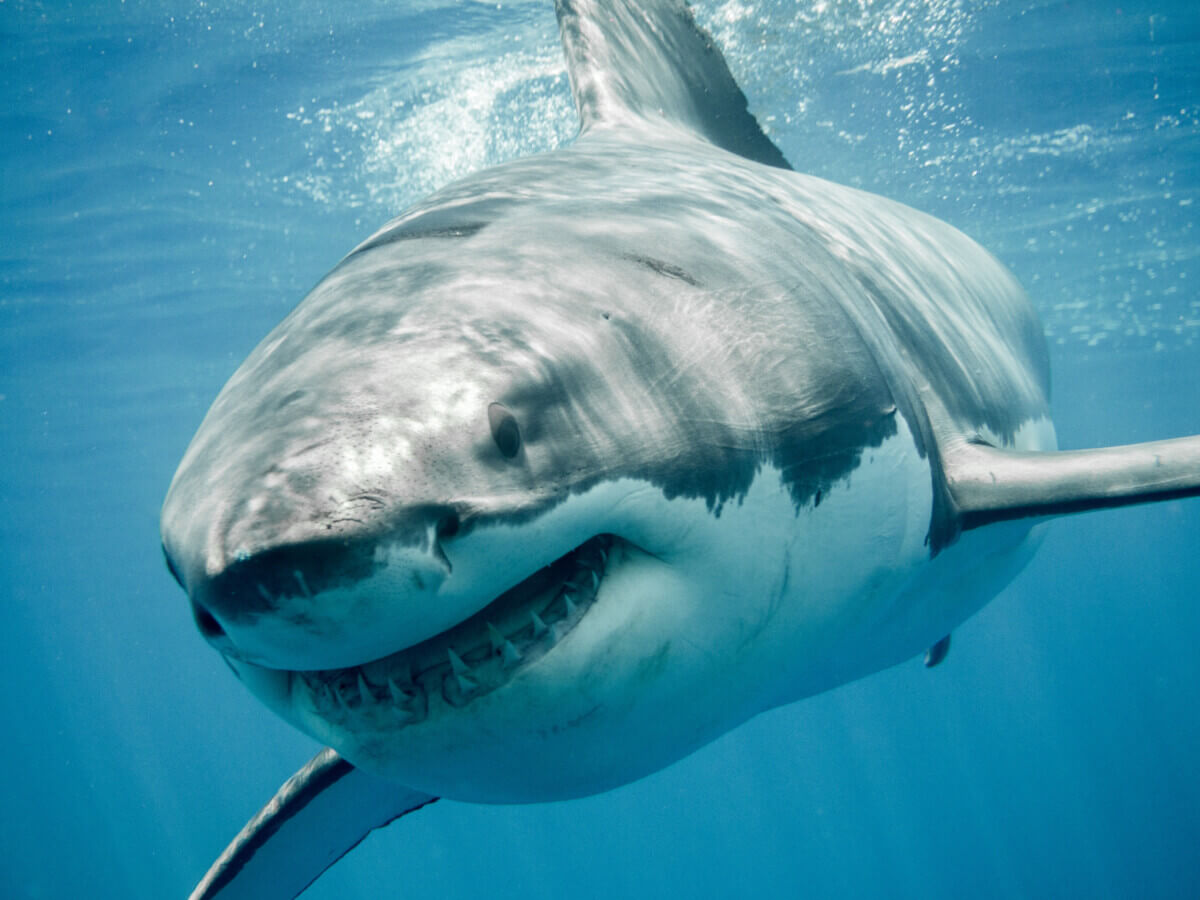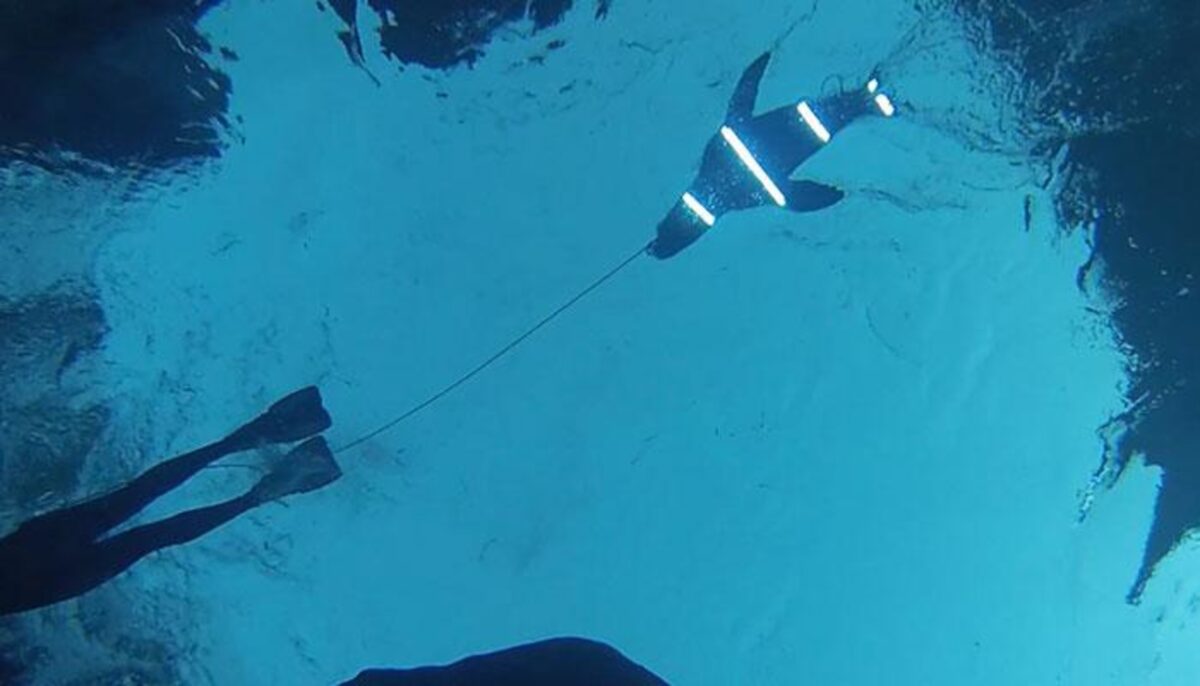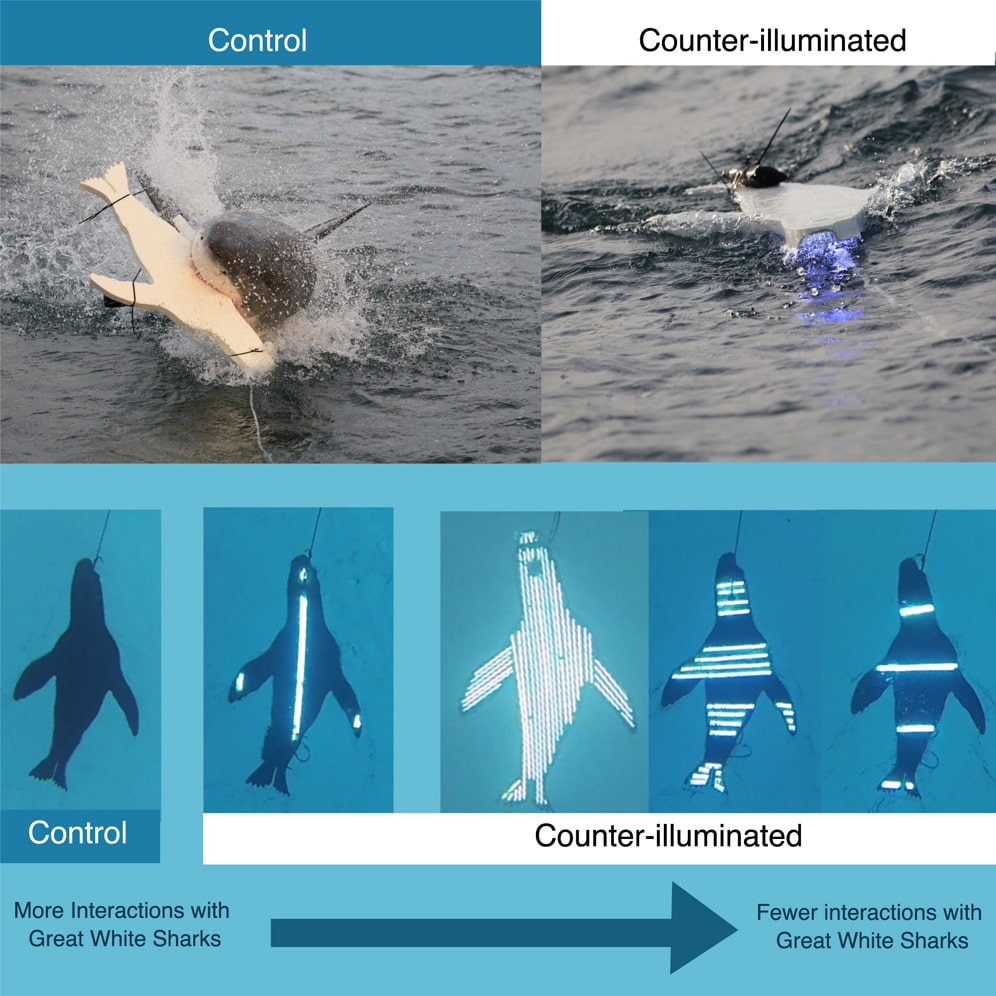
Great white sharks are responsible for most fatal shark attacks worldwide. (© ramoncarretero - stock.adobe.com)
In a nutshell
- Research shows that underwater LED lights can disrupt the silhouette of objects (like surfers or seal decoys), making them less likely to be identified as prey by Great White sharks, thus reducing the chances of attack.
- The study found that certain lighting patterns, particularly horizontal stripes, are particularly effective in deterring sharks. The lighting doesn’t need to cover the entire object, but rather disrupts the visual cues sharks rely on for prey recognition.
- This technology offers a promising alternative to harmful deterrents and shark culling, providing a way to prevent attacks without negatively impacting shark populations or marine ecosystems.
SYDNEY — The silhouette of a surfer paddling on their board looks remarkably like a seal from below, at least to a hungry Great White shark. But what if we could make that silhouette disappear? In a new international study, marine biologists have found that underwater LED lighting can effectively make humans “invisible” to sharks, offering a potential for preventing attacks while preserving these critical ocean predators.
Published in Current Biology, the research reveals that Great White sharks are significantly less likely to attack seal-shaped decoys equipped with LED lights on their undersides. This lighting technique, known as counterillumination, mimics a natural camouflage strategy used by many marine animals to hide their silhouettes from predators lurking below.
The researchers explain that sharks primarily identify potential prey by spotting dark shapes against the bright background of the sky when looking up from below. The research team discovered that disrupting this visual pattern through strategic lighting dramatically reduced shark attacks on the decoys.
“It’s sort of like an invisibility cloak but with the exception that we are splitting the object, the visual silhouette, into smaller bits,” says study author Nathan Hart from Macquarie University, in a statement. “It’s a complex interaction with the shark’s behavior. The lights have to be a certain pattern, a certain brightness.”
Shark Responses to Light

The team conducted experiments off the coast of South Africa, an area known for its Great White shark population. They towed seal-shaped decoys behind boats and systematically tested how sharks responded to different lighting configurations. They found that sharks consistently avoided attacking decoys with LED lights on their undersides, while frequently attacking identical unlit decoys.
The lights didn’t need to cover the entire underside of the decoy to be effective. Horizontal stripes of light were particularly effective at deterring sharks, suggesting the pattern disrupts the shark’s ability to recognize the shape as potential prey.
Lighting that exceeded the brightness of the surrounding environment effectively deterred sharks. Counterillumination works by creating visual disruption rather than by perfectly blending with background light levels.
For surfers, swimmers, and other ocean enthusiasts, this discovery presents a glimmer of hope. Current shark deterrent technologies have shown mixed results or rely on methods that can harm sharks, a species already facing significant conservation challenges.

Shark Vision and Hunting Behavior
When researchers arranged lights in horizontal stripes across the decoys, sharks still avoided them. However, when the same amount of lighting was arranged in vertical stripes, some sharks did attack—suggesting that a long, narrow silhouette more closely resembles their typical prey.
Scientists used sophisticated motion detection models to analyze how sharks might perceive these different lighting patterns. They discovered that horizontally striped lighting creates confusing motion cues that may make it difficult for sharks to track the object accurately.
The concept draws inspiration from nature. Many marine animals, from squid to some species of fish, use bioluminescent organs on their undersides to match the brightness of downwelling light, effectively erasing their silhouettes from predators below. This is the first study to demonstrate the effectiveness of this strategy as an anti-predation mechanism against Great White sharks.
Modifying silhouettes could form the basis for new shark deterrent technologies that help protect human lives. This non-invasive shark bite prevention technology that could be integrated into surfboards, wetsuits, or other water equipment.
While these findings show promise, the research team cautions that more testing is needed before commercial applications can be developed. Different shark species hunt using different strategies, and testing would need to be expanded to species like bull sharks and tiger sharks that are also responsible for attacks on humans.

The effectiveness of counterillumination also might vary depending on water clarity, time of day, and other environmental conditions. The research team noted that their dim lighting configuration was sometimes attacked during late morning hours when contrast between the lights and background was lowest.
However, this solution doesn’t harm sharks or rely on repellents that might damage marine ecosystems. Instead, it simply takes advantage of the visual cues sharks use when hunting, making humans less likely to be mistaken for prey.
Many shark attacks on humans result from “mistaken identity“—sharks confusing humans, particularly surfers, with their natural prey like seals. By disrupting the visual silhouette that triggers predatory behavior, counterillumination technology could reduce these tragic interactions without harming shark populations.
Interactions between people and sharks will inevitably increase. Rather than turning to harmful shark culls or dangerous deterrents, using light to disrupt hunting cues might be the simple solution that allows humans and sharks to peacefully coexist in our shared ocean home.
Paper Summary
Methodology
Researchers conducted field experiments in Mossel Bay, South Africa from 2014-2019, where they towed seal-shaped decoys behind boats and observed Great White shark interactions. The team created several versions of the decoys: control (white, unlit) versions and various counterilluminated versions with different LED light configurations on their undersides. They tested different light intensities (dim, moderate, and bright), as well as different light patterns including full coverage, horizontal stripes, and vertical stripes. Each experiment involved towing the decoys at 6-7 km/h along a consistent 1.2 km track in approximately 14m deep water. The researchers recorded shark interactions, classifying them as either “breaches” (where the shark bit or physically contacted the decoy) or “follows” (where the shark closely tracked the decoy). They also conducted laboratory analysis of the visual motion cues created by different lighting patterns using a two-dimensional motion detector model.
Results
The results showed that Great White sharks consistently avoided interacting with counterilluminated decoys. When testing fully lit undersides, sharks significantly preferred to attack the control decoys rather than the lit ones across all light intensities. Even when the decoys were towed side-by-side, sharks still chose to attack the unlit controls. The study found that horizontal stripes of light were particularly effective at deterring sharks, while vertical stripes were less effective (though still better than no lighting). The researchers discovered that counterillumination works primarily through disrupting the shark’s ability to recognize the silhouette as prey, rather than by perfectly matching background light levels. Their motion analysis revealed that horizontally striped lighting creates confusing visual cues that may make it difficult for sharks to track objects effectively.
Limitations
The researchers noted several limitations to their study. They conducted experiments only with Great White sharks in a specific location (Mossel Bay, South Africa), so results might not generalize to other shark species that use different hunting strategies. The experiments focused on surface predation behavior (breaching), which is only one type of shark hunting behavior. The effectiveness of counterillumination might vary with environmental conditions like water clarity, time of day, and light levels. Finally, the researchers emphasize that more testing would be needed before developing commercial applications, including tests with static decoys and in different predation scenarios.
Funding and Disclosures
The research was funded by the Western Australian State Government Applied Research Program, the NSW Shark Management Strategy annual grants program, the Sea World Research and Rescue Foundation, and an Australian Research Council Linkage Grant. The researchers disclosed that they are inventors and patent holders for a shark deterrent device based on this study (application no. 2023901539), indicating potential commercial interests in the technology.
Publication Information
The study titled “Counterillumination reduces bites by Great White sharks” was authored by Laura A. Ryan, Enrico Gennari, David J. Slip, Shaun P. Collin, Victor M. Peddemors, Charlie Huveneers, Lucille Chapuis, Jan M. Hemmi, and Nathan S. Hart. It was published in Current Biology (Volume 34, pages 5789-5795) on December 16, 2024.







